HL7 International Brand
Trademark Guidelines
Before using an HL7 trademarked logo, permission must be requested by visiting https://www.hl7.org/community-use/index.cfm. Once permission is granted and the logo files have been received, the guidelines below must be followed.
Identifying HL7 and HL7 Products
All materials developed for HL7 should clearly identify HL7 and the HL7 website URL. In addition, HL7 holds a number of registered trademarks which must be identified.
Name
- When referring to our organization, there are two acceptable formats:
- The full name: Health Level Seven® International
- The acronym: HL7 - Whenever writing copy about our organization, please make sure the first mention reads:
- “Health Level Seven® (HL7®) International” - After the full name has been used, subsequent references may use just the initials: “HL7”
- IMPORTANT: Do not use “Health Level 7” or any other expression.
URL
Our preferred format: HL7.org
Trademarks
Whenever using an HL7 graphic that includes a registered trademark symbol, a trademark statement must be placed near the first use of that graphic. For example:
®Health Level Seven, HL7, CDA, FHIR and the FHIR [FLAME DESIGN] are registered trademarks of Health Level Seven International, registered with the United States Patent and Trademark Office. These trademarks are used with the permission of HL7 and the use of these trademarks does not constitute HL7’s approval or endorsement.
Request a Logo for Official Use
Identifying HL7 Products Names
- Whenever writing copy about HL7 product names referenced in this guide, please ensure that you first list out the product’s full name for the first mention.
For example:
• HL7 Fast Healthcare Interoperability Resources (HL7 FHIR®)
• HL7 Clinical Document Architecture (HL7 CDA®)
• HL7 Version 2 (HL7 V2) - After the full name has been used, subsequent references may use the acronyms:
• FHIR
• CDA
• V2 - Whenever these trademarked products are mentioned, the trademark statement at left must accompany it somewhere in the document. For detailed information see “Guide to Using HL7 Trademarks” at https://www.HL7.org/legal/trademarks.cfm
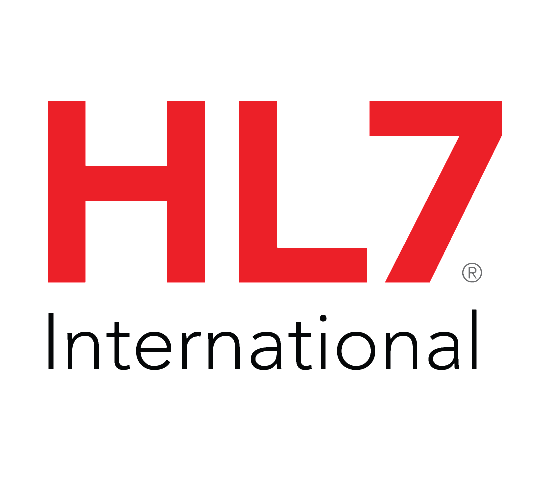
Using the HL7 Logo
The logo consists of three parts:
- the HL7 mark
- the registration mark
- the word “International”
Always use the entire logo graphic
Do not crop out the registration mark or the word “International”
Official logo colors
The HL7 logo uses specified colors:
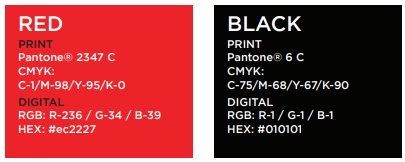
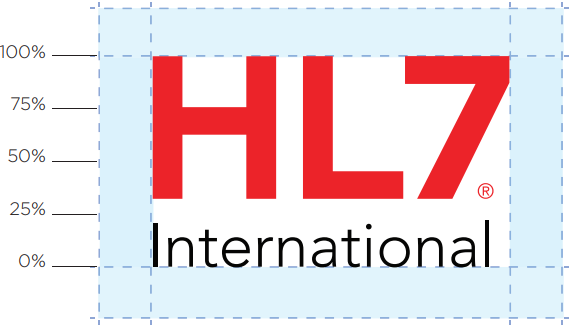
Exclusion zones
Always allow a clear area around the logo, measuring at least 25% of the vertical height of the logo.
Minimum width
The logo minimum width for print is 30 mm wide.
The logo minimum width for screen use is 100 pixels wide.
Do not change the logo form in any way
Derivative versions of the HL7® International logo are generally prohibited, as they dilute the brand identity. The logo must stand alone and may not be combined with any other object, including but not limited to other logos, words, graphics, photos, slogans, numbers, design features, or symbols. The logo may not be animated, morphed, or otherwise distorted in perspective or appearance. Do not approximate or re-create the logos. Please request original logo files from HL7 at https://www.HL7.org/community-use/index.cfm

Acceptable Variations of the Logo
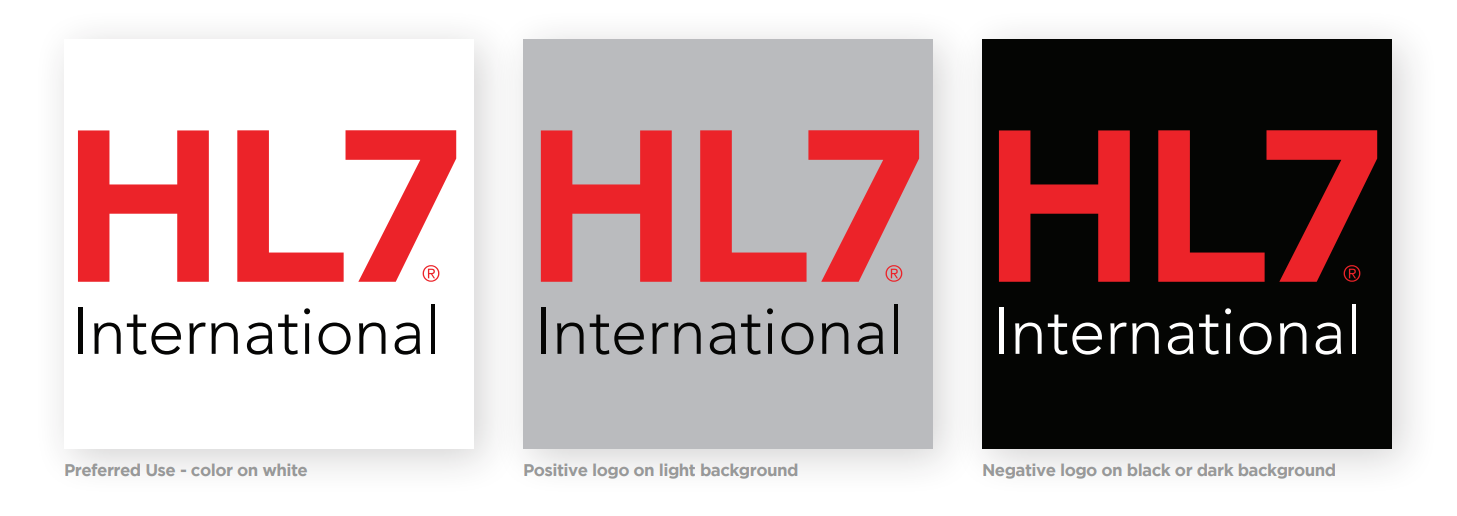
Placing the HL7 Logo for maximum legibility
Make the logo easy to see.
If the logo must be placed over a photo background, consider the placement of the logo carefully. Is there a natural light or dark point in the photo? Are some areas busy, while others are quiet?

Secondary Logos
HL7 FHIR

Exclusion zones
Always allow a clear area around the logo, measuring at least 25% of the vertical height of the logo.
Minimum width
The logo minimum width for print is 30 mm wide.
The logo minimum width for screen use is 75 pixels wide.
Do not change the logo form in any way
Derivative versions of the HL7® FHIR® logo are generally prohibited, as they dilute the brand identity. The logo must stand alone and may not be combined with any other object, including but not limited to other logos, words, graphics, photos, slogans, numbers, design features, or symbols. The logo may not be animated, morphed, or otherwise distorted in perspective or appearance. Do not approximate or re-create the logos. Please request original logo files from HL7 at https://www.HL7.org/community-use/index.cfm

HL7 V2

Exclusion zones
Always allow a clear area around the logo, measuring at least 25% of the vertical height of the logo.
Minimum width
The logo minimum width for print is 30 mm wide.
The logo minimum width for screen use is 300 pixels wide.
Do not change the logo form in any way
Derivative versions of the HL7® V2® logo are generally prohibited, as they dilute the brand identity. The logo must stand alone and may not be combined with any other object, including but not limited to other logos, words, graphics, photos, slogans, numbers, design features, or symbols. The logo may not be animated, morphed, or otherwise distorted in perspective or appearance. Do not approximate or re-create the logos. Please request original logo files from HL7 at https://www.HL7.org/community-use/index.cfm

HL7 CDA

Exclusion zones
Always allow a clear area around the logo, measuring at least 25% of the vertical height of the logo.
Minimum width
The logo minimum width for print is 30 mm wide.
The logo minimum width for screen use is 300 pixels wide.
Do not change the logo form in any way
Derivative versions of the HL7® CDA® logo are generally prohibited, as they dilute the brand identity. The logo must stand alone and may not be combined with any other object, including but not limited to other logos, words, graphics, photos, slogans, numbers, design features, or symbols. The logo may not be animated, morphed, or otherwise distorted in perspective or appearance. Do not approximate or re-create the logos. Please request original logo files from HL7 at https://www.HL7.org/community-use/index.cfm

HL7 FHIR Da Vinci Project

Exclusion zones
Always allow a clear area around the logo, measuring at least 25% of the vertical height of the logo.
Minimum width
The logo minimum width for print is 30 mm wide.
The logo minimum width for screen use is 300 pixels wide.
Do not change the logo form in any way
Derivative versions of the HL7® FHIR® Da Vinci Project logo are generally prohibited, as they dilute the brand identity. The logo must stand alone and may not be combined with any other object, including but not limited to other logos, words, graphics, photos, slogans, numbers, design features, or symbols. The logo may not be animated, morphed, or otherwise distorted in perspective or appearance. Do not approximate or re-create the logos. Please request original logo files from HL7 at https://www.HL7.org/community-use/index.cfm

HL7 FHIR Vulcan
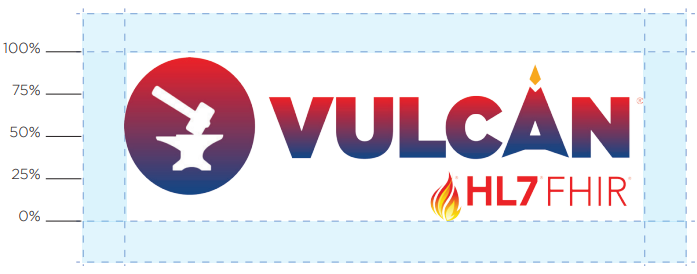
Exclusion zones
Always allow a clear area around the logo, measuring at least 25% of the vertical height of the logo.
Minimum width
The logo minimum width for print is 30 mm wide.
The logo minimum width for screen use is 300 pixels wide.
Do not change the logo form in any way
Derivative versions of the HL7® FHIR® Vulcan logo are generally prohibited, as they dilute the brand identity. The logo must stand alone and may not be combined with any other object, including but not limited to other logos, words, graphics, photos, slogans, numbers, design features, or symbols. The logo may not be animated, morphed, or otherwise distorted in perspective or appearance. Do not approximate or re-create the logos. Please request original logo files from HL7 at https://www.HL7.org/community-use/index.cfm

HL7 FHIR Argonaut Project
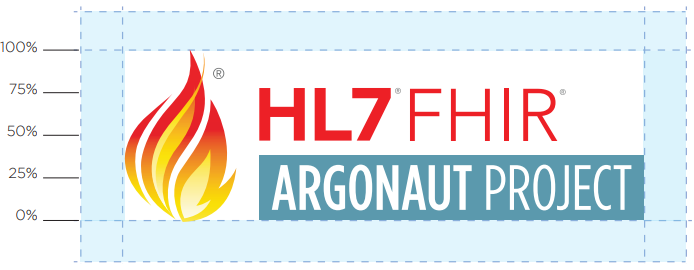
Exclusion zones
Always allow a clear area around the logo, measuring at least 25% of the vertical height of the logo.
Minimum width
The logo minimum width for print is 30 mm wide.
The logo minimum width for screen use is 300 pixels wide.
Do not change the logo form in any way
Derivative versions of the HL7® FHIR® Argonaut Project logo are generally prohibited, as they dilute the brand identity. The logo must stand alone and may not be combined with any other object, including but not limited to other logos, words, graphics, photos, slogans, numbers, design features, or symbols. The logo may not be animated, morphed, or otherwise distorted in perspective or appearance. Do not approximate or re-create the logos. Please request original logo files from HL7 at https://www.HL7.org/community-use/index.cfm

Affiliate Logos
Each Affiliate manages their own logo
Affiliates are also free to develop their own trademarks and domain names, provided such trademarks and domain names:
- Are not confusingly similar to the HL7 International Trademarks or domain names, or those of other Affiliates; and,
- Are approved in advance of use or registration, by the HL7 International Executive Committee, if such proposed trademarks
Questions? Concerns?
.png)
HL7 is here to help!
If you have questions or concerns about logo use, please reach out to HL7 Marketing and Communications at
marcom@HL7.org
To request an HL7 logo for official use, please visit https://www.hl7.org/community-use/index.cfm
If you have seen a logo you think might be in violation of the above guidelines, you can Report Suspected Trademark Abuse
.png?width=125&height=74&name=HL7_International_tucked-inR(1).png)